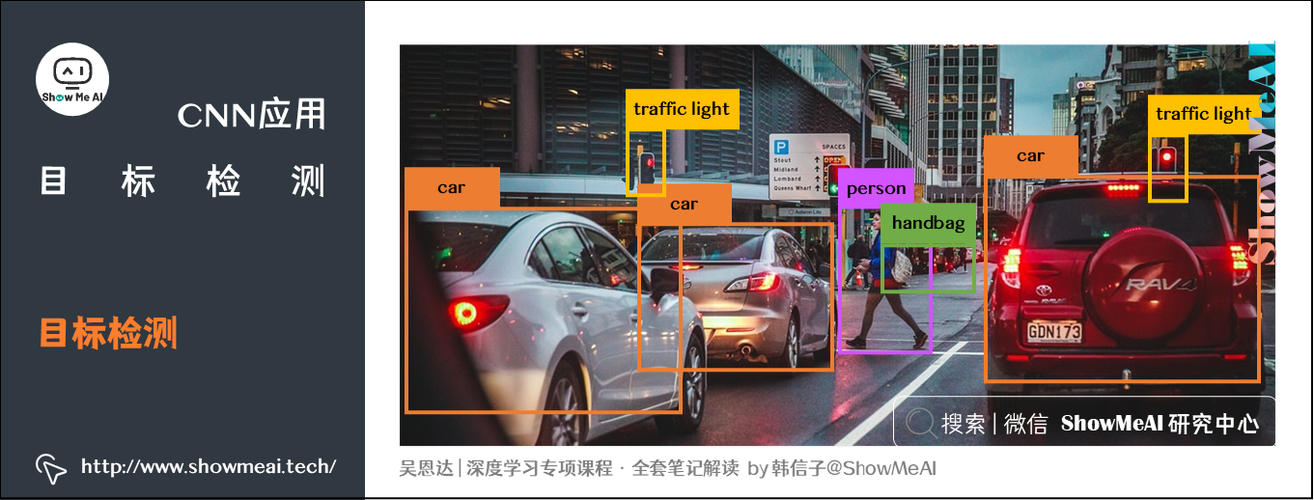YOLOv3算法的原理与应用:深度解析与实战指南
发布时间: 2024-08-14 03:51:53 阅读量: 40 订阅数: 37 


# 1. YOLOv3算法概述**
**1.1 YOLOv3的演进与特点**
YOLOv3是YOLO系列目标检测算法的第三代,它在YOLOv2的基础上进行了多项改进,包括:
* 引入Darknet-53作为主干网络,增强了特征提取能力。
* 采用FPN(特征金字塔网络)结构,融合不同尺度的特征,提升小目标检测精度。
* 改进损失函数,加入GIOU(广义交并比)损失,提高目标定位的准确性。
**1.2 YOLOv3的网络结构与模型训练**
YOLOv3的网络结构主要包括:
* **主干网络:**Darknet-53,负责提取图像特征。
* **特征金字塔网络:**将主干网络的特征图融合,形成不同尺度的特征图。
* **检测头:**在每个尺度的特征图上进行目标检测,预测目标的类别和位置。
模型训练过程主要包括:
* **数据预处理:**将图像和标签进行预处理,包括缩放、裁剪、增强等操作。
* **网络初始化:**使用预训练的Darknet-53权重对网络进行初始化。
* **优化算法:**采用SGD或Adam优化器,更新网络权重。
* **损失函数:**使用包含分类损失、定位损失和GIOU损失的复合损失函数。
# 2. YOLOv3算法原理
### 2.1 目标检测基础知识
目标检测是计算机视觉中的一项基本任务,其目的是在图像或视频中识别和定位感兴趣的物体。目标检测算法通常分为两类:
- **两阶段算法:**首先生成候选区域,然后对候选区域进行分类和定位。例如,R-CNN、Fast R-CNN和Faster R-CNN。
- **单阶段算法:**直接从图像中预测目标的边界框和类别。例如,YOLO、SSD和RetinaNet。
### 2.2 YOLOv3的特征提取与目标定位
YOLOv3采用Darknet-53作为特征提取网络。Darknet-53是一个卷积神经网络,由53个卷积层和5个最大池化层组成。它能够从图像中提取丰富的特征信息。
YOLOv3将输入图像划分为一个S×S的网格。对于每个网格单元,YOLOv3预测B个边界框和C个类别概率。边界框由中心坐标、宽高和置信度组成。置信度表示边界框包含目标的可能性。
YOLOv3使用逻辑回归函数计算边界框的置信度:
```python
confidence = sigmoid(p_c)
```
其中,p_c是边界框包含目标的概率。
### 2.3 YOLOv3的损失函数与优化算法
YOLOv3的损失函数由三部分组成:
- **定位损失:**衡量预测边界框与真实边界框之间的距离。
- **置信度损失:**衡量预测置信度与真实置信度之间的差异。
- **分类损失:**衡量预测类别概率与真实类别概率之间的差异。
YOLOv3使用Adam优化算法进行训练。Adam是一种自适应学习率优化算法,能够根据梯度的二阶矩估计调整学习率。
**代码块:**
```python
import tensorflow as tf
def yolo_loss(y_true, y_pred):
"""YOLOv3的损失函数
Args:
y_true: 真实标签
y_pred: 预测结果
Returns:
损失值
"""
# 定位损失
loc_loss = tf.reduce_mean(tf.square(y_true[:, :, :, :4] - y_pred[:, :, :, :4]))
# 置信度损失
conf_loss = tf.reduce_mean(tf.square(y_true[:, :, :, 4] - y_pred[:, :, :, 4]))
# 分类损失
class_loss = tf.reduce_mean(tf.square(y_true[:, :, :, 5:] - y_pred[:, :, :, 5:]))
# 总损失
loss = loc_loss + conf_loss + class_loss
return loss
```
**代码逻辑分析:**
* `y_true`和`y_pred`都是形状为`[batch_size, S, S, 5+C]`的张量,其中`S`是网格大小,`C`是类别数。
* `loc_loss`计算预测边界框与真实边界框之间的均方误差。
* `conf_loss`计算预测置信度与真实置信度之间的均方误差。
* `class_loss`计算预测类别概率与真实类别概率之间的均方误差。
* `loss`将三个损失项相加得到总损失。
# 3. YOLOv3算法实践
### 3.1 YOLOv3模型的部署与配置
#### 部署环境准备
部署YOLOv3模型需要准备以下环境:
- 操作系统:Ubuntu 16.04或更高版本
- Python版本:3.6或更高版本
- TensorFlow版本:1.14或更高版本
- OpenCV版本:3.4或更高版本
#### 模型下载与解压
下载预训练的YOLOv3模型权重文件,并解压到指定目录。
#### 配置配置文件
创建配置文件`config.py`,指定模型权重文件路径、
0
0





